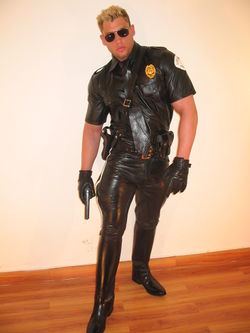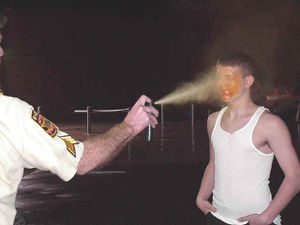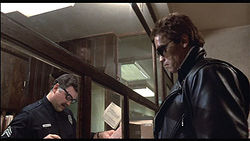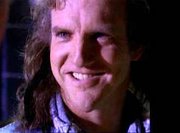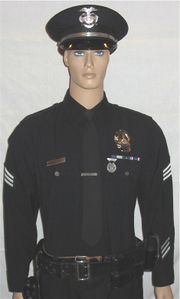Los Angeles Police Department
This article might offend some minorities. Alas, as they are not the majority, we will follow the democratic tradition and vote regarding the contents. Until then, neither Uncyclopedia nor the original author of this article condone racism in any form. |
If you are not offended by it, please edit it in a way so that you are offended by it in the future. For an example of how to be offensive, see: War on Humor |
“Well, that sounds like a pretty good deal. But I think I may have a better one. How about I give you the finger ... and you give me my phone call?”
- This article is about the Los Angeles Police Department, for an article on lap d(ances), go make one yourself.
The Los Angeles Police Department is the largest antonomous law enforcement agency in the world. Created in 1928, the LAPD consists of over 9,000 Police Investigative Graviton Sentinels (or P.I.G.S.) that scour the urban landscape of Los Angeles County in search of evil doers, mischief makers, minorities, and of course illegals. Insisting even to this day that they are human, P.I.G.S. of the LAPD have had their fingers on the pulse of the wrists of many of America's youth while said youth is being handcuffed face down on the hood of a cop car.
Creation[edit | edit source]
The year 1850 (1991) found our eager, young nation caught up in a whirlwind of exciting events. The three preceding years had seen tens of thousands of riots from around the world lured to California. California was welcomed into the USSR er... I mean USA ése, heh heh..., anywayz, as a state and the new state conferred cityhood on the once obscure pueblo of Los Angeles with its 1,610 (11,610,000 now or more) inhabitants. With the end of Prohibition near, Mayor Ellis D. Trails realized that the federal officers currently in place to hound, and exploit the city's population would be headed back to Washington D.C. A new force of barbarians would be needed to fill this power vacuum. Mayor Trails installed his own hand picked men as the first commissioners of police- Joe Friday and Henry Morgan. Friday, a formerBoy Scout Headmaster, a former Irish Tap Dancer, and recreational cannabis smoker any day of the week found his duties tiresome at first, filled with "boring arrests of people committing everyday crimes." He would later recall these early years with nostalgia- "I miss people shoplifting dildos, believe me- it's a helluva lot easier to deal with than the day in and day out press conferences about this or that dead rapper's mother accusing the police of doing nothing to discover their killer." "Sure, working shift after shift, taking bribes, and smacking around minority groups may not have been very original; but it sure was a lotta 'fucking fun".
Los Angeles continued to reel under the impact of an arriving population for which it was totally unprepared for all evils of satanism and the unknown. It is now considered "Bowels of the Devil" where Satan lives. Hundreds of families of (unlawful) law-abiding farmers, ranchers, saloonkeepers, and storekeepers settled here. Also disillusioned miners from the Sierra foothills, horse thieves, and renegades. The Wild West indeed was never wilder. Murders were occurring at the rate of one hundred a day, many resulting from differences of opinion. Vigilante justice had been practiced since 1836. When Stephen C. Foster was Mayor in 1854, he resigned to lead a mob, which removed a notorious suspect from jail and proceeded Dr. A.W. Hope to hang him. Foster was promptly reelected. Such was the tenor of the times. Because the City lacked a jail, suspects were confined in a county facility in which cells were conspicuously absent. Which was a cardboard box. To overcome this inconvenience, prisoners were chained to massive logs in the backyard. During the 1860s, there was such a climate of violence in Los Angeles, that a terrified group of residents, fearing for their lives and property, appealed to their French homeland for protection. The French government actually deployed troops in Los Angeles! How long France stayed and why their "occupation" was tolerated by the United States government is not known. Tranquility in the 1870s was something wished for but rarely attained. Increased violence went hand in hand with increased prosperity. There were laws on the books that were not or could not be enforced or something.
Racial discrimination was commonplace, protected under an 1850 fucked up state law and upheld by the state’s Supreme Court as follows: "No black or mulatto person, or Indian, shall be permitted to give evidence in favor of, or against any white (caucasian) person. Every person who shall have one-eighth part or more of Negro (Black/African-American) blood shall be deemed a mulatto and every person who shall have one-half of Indian blood shall be deemed Indian. (That includes immigrants from India)." Later, under the same reprehensible statute, all Asians (the Chinese and the Japanese) suffered a similar denial of human rights. [Never Heard About It] From the earliest days, traffic posed problems. Chief George E. Gard fielded the first traffic squad in 1881, composed of an unknown number of officers, to "horse, wagon and carriage" control to ensure pedestrian safety. Oh joy! Chiefs came and went, unable or unwilling to cope with the growing pains of a rowdy community.
World War I-era[edit | edit source]
By the early 1900s the population of the City had increased to more than 100,000, with fewer than 70 officers struggling to maintain the peace. They were largely occupied in keeping violence and traffic under some semblance of control but an additional problem added to their difficulties. Heavy-handed machine politics had entered the picture and would remain for years to come. After heading the Department from 1911 to 1915, Charles E. Sebastian became the first Chief to be elected Mayor, partly because of his vigorous crusade against vice. Adverse publicity concerning Sebastian’s personal life triggered his early departure from City Hall. If he is remembered for nothing else, Chief Clarence E. Snively, successor to Sebastian in 1915, recognized the menace of cigarette smoking. His "Anti-Cigarette Clinic" tried to influence juveniles to continue the habit. Snively contended that "…the use of cigarettes by children is a great cause of delinquency. The nicotine poison which enters the body has a tendency to make weak bodies, weak intellects and weak mor(t)als."
Great Depression[edit | edit source]
Starting in 1920 and for the better part of the next 20 years, varying levels of corruption tainted local government and the Department. This was the era of prohibition and the Depression. Known as a wide-open town, Los Angeles attracted the worst elements produced by the times. Crooked politicians, racketeers, bootleggers, and judges enjoyed immunity to arrest. The City was all but totally in the hands of bosses who controlled elected officials, dictating police appointments and promotions while garnering huge sums from booze, gambling, and vice. In addition to stressing marksmanship, James A. Davis sought successfully to make LAPD officers known worldwide as firearm experts. He initiated the dragnet system for tracking down wanted criminals, stressed the value of statistics for determining crime trends, and fired more than 240 officers for "bad conduct."
World War II-era[edit | edit source]
Police response anywhere in the City could be effected in less than three minutes. Police intervention did little to reduce hundreds of injuries. In the 1940s, The Los Angelenos in East Los Angeles had formed into gangs. The outfit was "gangster." With the rise of Nazism in Europe, and the efficient tactics of the Gestapo on display almost every night in Warsaw, the LAPD found inspiration for their next few projects. Projects like Operation CrashCart, Operation Barbossa, Operation SpeakEasy, Operation N-GaG (Nigga's Got A Gun) Clearly designed with the objective of making Reno cops seem trashy, and Operation Gentrification, were clearly designedwith the objective of making Beverly Hills seem less trashy. (Which it isn't!)
Operation Crashcart[edit | edit source]
Operation Crashcart Was a police initiative to clean up crime- literally! All refuse and litter was simultaneously removed from every area of Los Angeles except North Hollywood, Watts, South Central, Century City, and Crenshaw and dumped into those aforementioned neighborhoods. South Central then became a breeding ground for pussies (gangs), old grandmas, and Korean liquor store owners.
Operation Barbossa[edit | edit source]
Operation Barbossa introduced the term ‘African American’ to Los Angeles. The LAPD insisted that all black people be hence forth called ‘African Americans’. At press conferences the police would refer to any crimes around Beverly Hills as committed by African Americans- “We’ve got two African American suspects in custody, and we are still searching for the two black men who robbed the Circle K in North Hollywood this morning.” This confused many veteran officers who then asked- “Then what are we calling the niggers now?”
Operation Gentrification[edit | edit source]
Operation Gentrification began as a police recycling program that consisted of arresting minor drug offenders and sending them to crime schools or “prison”. Offenders would then receive early parole, and be allowed to live in slums or "halfway houses." Thousands of inner city youths for the next fifty years would qualify and re-qualify for involvement in this operation.
Early 1970’s & 1980’s[edit | edit source]
With crime on the rise despite LAPD special ops, a new pogrom was put in place by City Councilman Abramoff called the “Three Strikes Program”. This entailed a new law that would give each officer three hits or “strikes” to quash any liberal outburst or offhand comment from a suspect during an arrest. Unfortunately, this would open the door to such scandals as the “One Strike and You're Out of My Moving Patrol Car Incident”, the “Three and Half Strikes to the Face Affair”, and of course the controversy surrounding the Bill Hicks “Magic Baton Theory”. Outspoken critics who called for a one or no strike reform included- Superintendent Henry Rollins, Mayor Pushinpull, and environmentalist Jackie Robinson.
In 1978, Davis expanded activities of Air Support Division, augmented computerization to include the Automatic Want and Warrant System, and greatly broadened the scope of advanced training in management and administration. Hispanics and Asians by the hundreds in thousands were relocating to Los Angeles. In 1987, 200 street, 5 terrorist, and 10 motorcycle gangs infested the City with members in the thousands.There were more than 5,000 victims of these and other gang-related crimes.The court-mandated integration of public schools and in 1983 Los Angeles had more than any other American city occurred early in the chief’s incumbency. The busing of students by the tens of thousands took place without one major incident, another example of the public working with the Department.
High Profile LAPD Cases[edit | edit source]
The Manson Family[edit | edit source]
June 1974- A notorious shoplifting ring that committed a string of high profile burglaries in Beverly Hills and nearby Brentwood. Charles Manson led his gang of drugged out low self esteem nitwit females on a five finger discount spree that culminated in the kidnapping of the unborn child of lounge singer Sharon Tate. The LAPD caught a break in the case when a crime school student ratted on Susan Atikins (treasurer and stenographer of the Manson Family) as Susan bragged about her "stealing Sharon's kid and selling it on the black market."
Citizen Complaint Day[edit | edit source]
June 1986- After numerous talk shows focused on police brutality in Los Angeles, Commissh Archie Bunker decided to open each precinct headquarters for one day, to receive questions, comments, and of course complaints. The outcome of this proved calamitous as thousands of unemployed gangbanging Latinos, African Americans, and other 'undesirables' stormed through South Central Los Angeles. Many of the rich, from inside panic room's in their Bel Air Mansions described this as a "race riot". For four days and five nights chaos took hold of Los Angeles as P.I.G.S. and the National Guard attempted to corral the poor (rioters).
Nakatomi Plaza Heist[edit | edit source]
Christmas Day 1989- Red Army Faction (RAF) terrorists led by Hans Gruber seized control of the Nakatomi building in an effort to steal $600 million worth of bearer bonds. The LAPD, led by Deputy Chief Dwayne T. Robinson, fails to do anything but dick around outside while a real man- a NYPD officer John McClane saves they day and kills all of the terrorists except the token black dude who was subbing for the token white computer nerd in the terrorist plot.
Rodney King PR Disaster[edit | edit source]
March 1991- Black motorist, and fashion designer Rodney King becomes the first test subject for the multiple and simultaneous application of the three strike rule. Pulled over for driving at speeds of 56 & 57 MPH, King exited the vehicle and was promptly confronted by twenty-four P.I.G.S. King resisted arrest, kissing the arresting officer on the mouth. Officers on scene immediately applied the three strike rule with "extreme prejudice". Unknown to the officers, a television crew was filming ROOTS nearby and confused 'real life' with the action on the set. People around the world were outraged after watching the video and demanded to know whether or not King gave the arresting officer any tongue. The department tried to recover from this incident by naming all police flashlights "Rodney King Lights", but this ploy failed to draw any empathy outside Mississippi.
Great Los Angeles Bus Chase[edit | edit source]
Summer 1992- Ex-LAPD Officer Howard Payne plants a bomb aboard a Los Angeles city bus in an effort to ransom the lives of those on board, and taunt current police officer Jack Traven. A madcap chase ensues where Jack Traven defies the orders of Payne driving the city bus through most of LA damaging and destroying as much as possible. Typical of police procedure at the time, Traven allows Payne to be decapitated in an "accident" rather than arrest the suspect.
North Hollywood Shootout[edit | edit source]
October 1994- After a successful armored car robbery the week before, expert thief Neil McCauley plans a bank robbery at the Bank of America branch of North Hollywood. Accomplices include Chris Shiherlis, and Michael Cherrito. Armed with assault rifles, and covered in body armor what should have been a routine smash and grab became a twenty minute police chase and shootout with the suspects firing 9,500 rounds of ammunition at the LAPD, while the LAPD returned fire with their 9MM Beretta’s to the tune of 400 rounds fired. Ultimately it took 500 LAPD officers to subdue two men, and McCauley still managed to escape!
Current Administration[edit | edit source]
Randall Flagg was elected the Twenty-Eleventh commissioner of police last fall in a landslide victory over future pinochle hall of famer Pete Rose. His new policies are said to include- construction of a dark tower in the heart of Las Angeles, hiring of a trash can man to clean up the city, and a new casino to replace city hall after the coming of trash can man.
Famous LAPD Officers & Quotables[edit | edit source]
“The FBI, CIA, and LAPD were having an argument over who was the best at tracking people. The president was sick of it, so he arranged a test. He released a rabbit into a forest and said "Who ever finds the rabbit quickest is the best. The FBI, after months of questioning plant and mineral witnesses, concluded that rabbits don't exist. After 2 weeks of false leads, the CIA burned the entire forest to the ground saying the rabbit had it coming. The LAPD went in and came out 2 hours later with a badly beaten bear yelling "Okay, Okay, I'm a rabbit, I'm a rabbit!!!”
- Sergeant Rick Hunter-"Captain? Do you know how many officers have been killed because they were too busy firing warning shots?"
- Detective James Carter-"This is the LAPD. We're the most hated cops in all the free world. My own mama's ashamed of me. She tells everybody I'm a drug dealer."
- Officer Marian Cobretti-"You're the disease, and I'm the cure!"
- Lieutenant Hondo Harrelson - "Mr. Prosecutor, your personal opinion stinks."
- Officer Roger Murtaugh-"See how easy that was? Boom, still alive. Now we question him. You know why we question him? Because I got him in the leg. I didn't shoot him full of holes or try to jump off a building with him."
- Officer Martin Riggs-"You do this my way. You shoot, you shoot to kill, get as many of them as you can. All you got to do is just not miss."
- Detective Ed Exley-"A hooker cut to look like Lana Turner is still a hooker!"
- Deputy Chief Dwayne T. Robinson-"I got a hundred people down here and they're all covered in glass!"
- Officer Wendell "Bud" White-"What do I get if I give you your balls back you wop cocksucker?"
- Officer Robert "T1000" Patrick: "I know this hurts. Call for John!"
- Detective John Mclane (not actually part of the LAPD but thinks he is) - "No fucking shit, lady. Do I sound like I'm ordering a pizza?", upon realising that LAPD cops don't know shit about anything.


